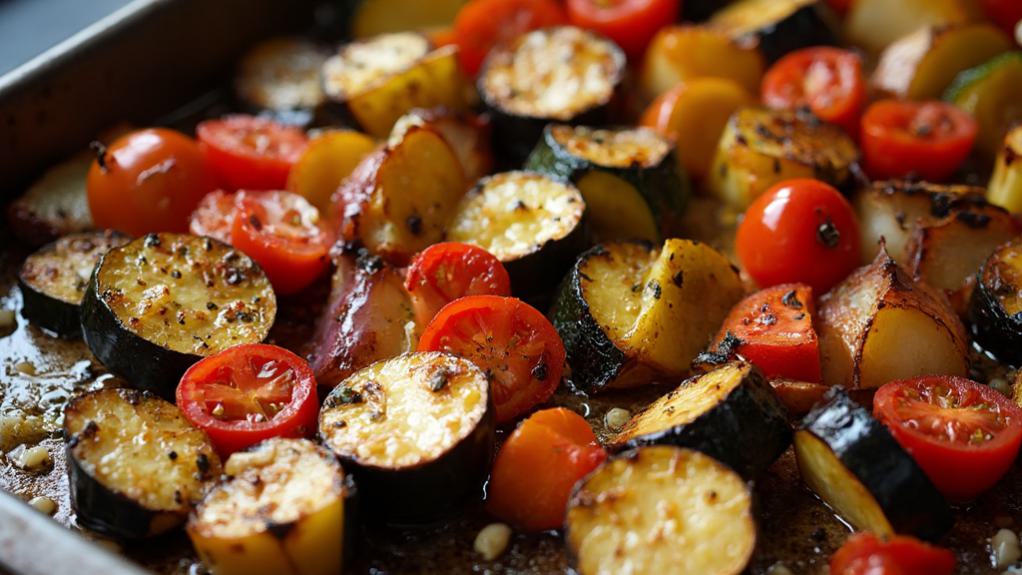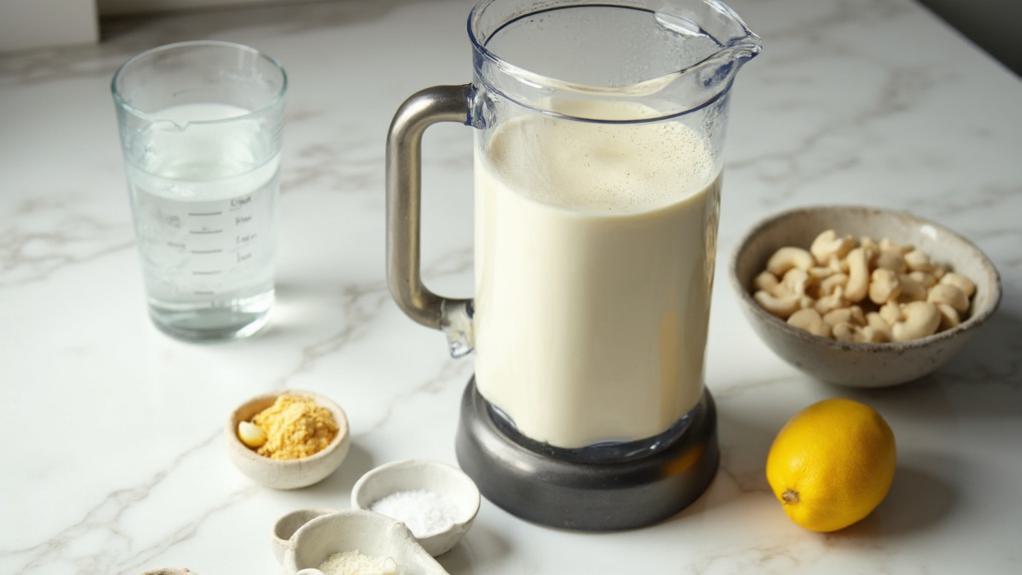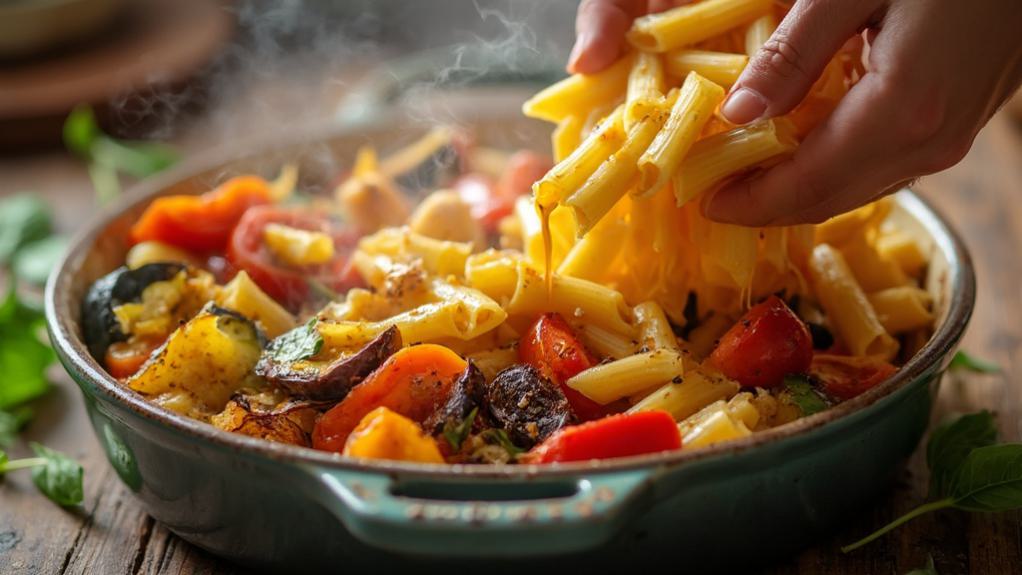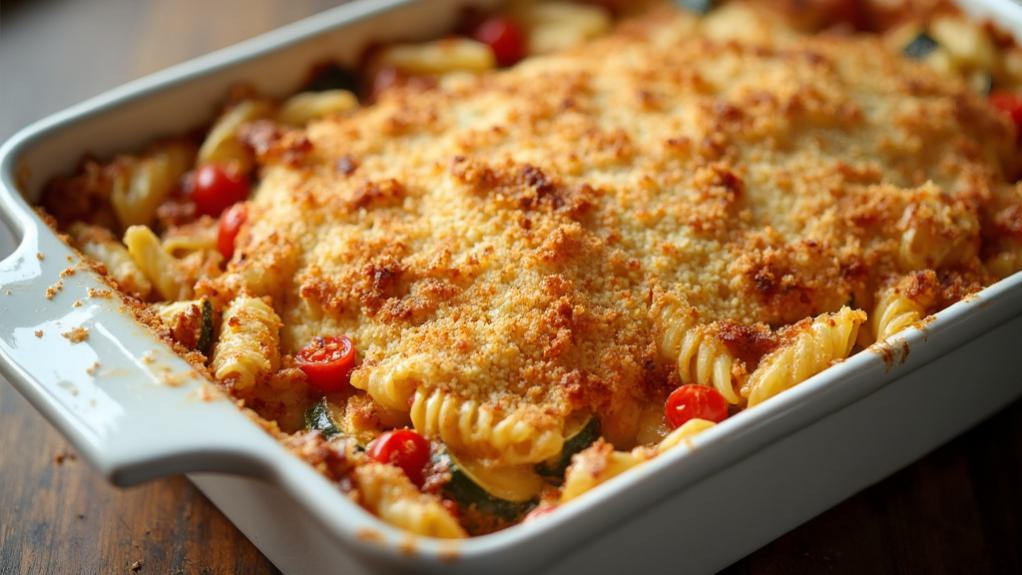I’ve often contemplated whether the success of a pasta bake lies more in its components or in its execution, and after years of perfecting this roasted vegetable version, I’m convinced it’s an intricate dance of both. The transformation of humble vegetables through careful roasting, combined with perfectly al dente pasta and my signature cashew cream sauce, creates something far greater than its individual elements would suggest.
While many attempt this dish with varying results, I’ve discovered several nuanced techniques that elevate it from a simple casserole to an elegant centerpiece worthy of both casual suppers and sophisticated dinner parties.
Recipe
Mediterranean Roasted Vegetable Pasta Bake brings together the wholesome goodness of seasonal vegetables with hearty pasta, creating a satisfying vegan main dish. The combination of roasted vegetables, aromatic herbs, and a creamy cashew sauce transforms simple ingredients into a comforting meal that’s perfect for any occasion.
The magic of this dish lies in the roasting process, which caramelizes the vegetables and intensifies their natural flavors. When combined with perfectly cooked pasta and blanketed in a rich cashew cream sauce, topped with crispy breadcrumbs, it creates a harmonious blend of textures and tastes that will satisfy both vegans and non-vegans alike.
- 16 oz penne pasta
- 2 zucchini, cut into chunks
- 2 red bell peppers, sliced
- 1 eggplant, cubed
- 2 cups cherry tomatoes
- 1 red onion, sliced
- 4 cloves garlic, minced
- 2 cups cashew cream sauce
- 1 cup panko breadcrumbs
- 2 tablespoons olive oil
- 1 teaspoon dried basil
- 1 teaspoon dried oregano
- Salt and black pepper to taste
- Fresh basil leaves for garnish
Preheat oven to 400°F (200°C). Toss prepared vegetables with olive oil, garlic, dried herbs, salt, and pepper on a large baking sheet. Roast for 25 minutes, stirring halfway through.
Meanwhile, cook pasta according to package instructions until al dente. In a large baking dish, combine the roasted vegetables, cooked pasta, and cashew cream sauce. Top evenly with breadcrumbs and bake for 20 minutes or until golden brown and bubbling. Allow to rest for 10 minutes before serving.
For the best texture, ensure the pasta is cooked al dente as it will continue to soften in the oven. Make the cashew cream sauce slightly thinner than desired as it will thicken during baking. Toast the breadcrumbs in a dry pan before topping the dish for extra crunch.
The dish can be assembled up to 24 hours in advance and refrigerated until ready to bake. Leftovers keep well in an airtight container for up to 4 days and can be reheated in the oven at 350°F until warmed through.
Step-By-Step Cooking Instructions
You’ll want to begin this elevated pasta bake by prepping all your vegetables and creating your cashew cream sauce, ensuring everything is ready for seamless assembly.
Next, you’ll focus on roasting the vegetables until they’re perfectly caramelized while simultaneously cooking your pasta to al dente and preparing the creamy sauce.
Finally, you’ll bring the components together in your baking dish, top with seasoned breadcrumbs, and transform the mixture into a golden-brown masterpiece through a final stint in the oven.
Step 1. Prep Ingredients Before Starting

Before diving into this exquisite pasta bake, gather and prepare your mise en place with meticulous attention to detail.
You’ll want to wash and dry all vegetables thoroughly, then proceed with precise cutting techniques: cube the eggplant into 1-inch pieces, chunk the zucchini into similar-sized portions, and slice the red bell peppers into uniform strips.
Halve the cherry tomatoes and cut the red onion into elegant crescents.
While organizing your vegetables, measure out your dried herbs and breadcrumbs into small prep bowls.
You’ll need your cashew cream sauce prepared in advance – ensure it’s slightly thinner than you might expect, as it will thicken during baking.
Set out your olive oil, salt, and pepper within arm’s reach of your workspace.
Prepare two large baking sheets with parchment paper for roasting vegetables, and have your pasta pot ready with water and salt.
Position your colander near the stovetop.
Finally, brush your baking dish with a light coating of olive oil to prevent sticking.
With everything precisely arranged, you’re now ready to begin the cooking process.
Step 2. Roast Vegetables Until Tender

With your mise en place meticulously arranged, the next phase focuses on transforming those raw vegetables into caramelized, tender morsels.
Begin by spreading your prepared zucchini, bell peppers, eggplant, cherry tomatoes, and red onion across two rimmed baking sheets, ensuring they’re arranged in a single layer to promote even cooking and optimal caramelization.
Drizzle the vegetables with olive oil, then sprinkle them with dried basil, oregano, salt, and pepper. Using your hands, gently toss the vegetables until they’re evenly coated with oil and seasonings. You’ll want each piece to glisten with a light sheen of oil, but not be saturated.
Position your oven racks in the upper and lower thirds of the oven, then slide in your baking sheets.
Roast the vegetables at 400°F for 25 minutes, rotating the pans halfway through the cooking process. You’ll know they’re done when the edges have developed a golden-brown color, the tomatoes have begun to burst, and the vegetables yield easily when pierced with a fork.
Don’t rush this step – proper caramelization is crucial for developing the dish’s complex flavor profile.
Step 3. Make Cashew Cream Sauce

Creating the silken cashew cream sauce begins with an overnight soak of raw cashews in cool water, allowing them to soften completely for the smoothest possible texture.
After draining, transfer the cashews to a high-speed blender, adding fresh water, nutritional yeast, garlic powder, and a pinch of salt.
You’ll want to blend the mixture on high speed for 2-3 minutes, pausing occasionally to scrape down the sides, until you achieve a luxuriously smooth consistency.
If the sauce appears too thick, add water in small increments until it reaches a pourable state, slightly thinner than your desired final texture, as it will thicken during baking.
Now’s the time to adjust the seasoning. Add a squeeze of lemon juice to brighten the flavors, and fine-tune the salt level to your preference.
For additional depth, you can incorporate a touch of white miso paste or a splash of white wine vinegar.
Once you’ve achieved the perfect balance, transfer your cashew cream sauce to a bowl, ready to envelop your pasta and roasted vegetables in its velvety embrace.
Step 4. Combine All Main Components

The harmonious union of each component marks the crescendo of this Mediterranean-inspired dish. You’ll now orchestrate the convergence of your perfectly cooked pasta, caramelized roasted vegetables, and velvety cashew cream sauce into a symphony of flavors and textures.
Begin by transferring your al dente pasta to a large mixing bowl, ensuring it’s well-drained. Gently fold in the roasted vegetables, taking care not to break them. Pour the cashew cream sauce over the mixture in stages, tossing delicately between additions to achieve even distribution. You’ll want every piece of pasta and every morsel of vegetable to be kissed by the sauce.
Transfer this magnificent medley to a 9×13-inch baking dish, spreading it evenly to create a uniform surface. Don’t compress the mixture too firmly; you’ll want small pockets throughout where the sauce can bubble and create delicious concentrations of flavor.
Crown your creation with a generous layer of breadcrumbs, ensuring complete coverage. The breadcrumbs will transform into a golden crust, providing a delightful textural contrast to the creamy layers beneath.
Step 5. Bake Until Golden Brown

Now that your masterpiece is assembled, precise baking will elevate it to golden-brown perfection.
Position your baking dish on the center rack of your preheated 400°F oven, ensuring adequate space for even heat distribution. You’ll want to bake the dish uncovered for 20 minutes, allowing the breadcrumb topping to achieve that coveted crispy texture.
Watch for visual cues during the final minutes of baking. The surface should develop a rich, golden-brown color, and you’ll notice the edges beginning to bubble gently. If needed, broil for 1-2 minutes to achieve extra crispiness, but don’t step away – the difference between perfectly browned and burnt is mere seconds.
Once you’ve achieved that picture-perfect golden crust, remove your pasta bake from the oven and let it rest for 10 minutes. This crucial resting period allows the cashew cream sauce to set properly, making it easier to portion and serve.
You’ll know it’s ready when the bubbling has subsided and the sauce has thickened slightly. The finished dish should showcase a striking contrast between the crispy top and the creamy, vegetable-laden interior.
Why I Love This Dish
Invariably, I’m drawn to this roasted vegetable pasta bake for its harmonious blend of rustic comfort and refined Mediterranean flavors. I cherish how the roasting process transforms ordinary vegetables into caramelized gems, each bringing its distinct character to the dish while creating a cohesive whole.
The way the cashew cream sauce seeps into every crevice of the pasta reminds me of traditional Italian gratins, yet it’s entirely plant-based.
What I find most compelling is this dish’s remarkable versatility. I can adapt it to any season’s produce, and it never fails to deliver satisfaction whether served at a casual family dinner or an elegant gathering.
The textural interplay between the crispy breadcrumb topping and the tender vegetables beneath creates a sensory experience that I’ve come to crave. I’m particularly fond of how the cherry tomatoes burst during roasting, releasing their sweet-acidic essence throughout the dish.
Beyond its immediate appeal, I appreciate how it gracefully transitions from dinner to next-day lunch, with flavors that actually deepen over time.
It’s this thoughtful marriage of practicality and sophistication that keeps me returning to this recipe.

Leave a Reply